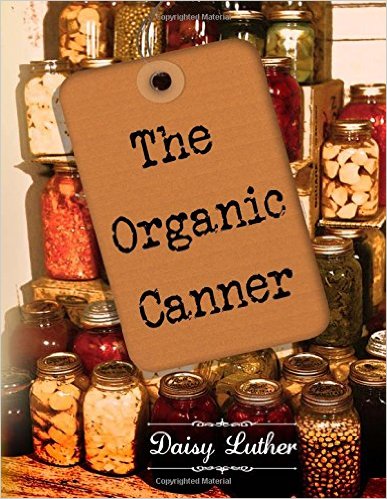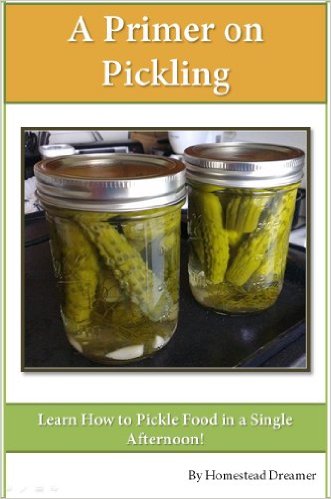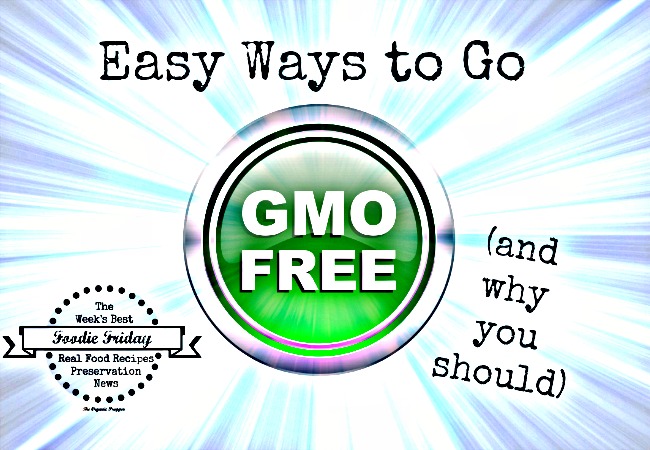If you're new here, you may want to subscribe to my RSS feed. Thanks for visiting!
Welcome to Foodie Friday. This is the GMO-free edition!
Want to make your kitchen GMO-free? This week’s round-up is loaded with news, tips, and recipes that can help!
This feature is chock-full of all things food related: news, preservation, and delicious real food recipes. As always, I really hope you’ll share your links and ideas in the comments below. As well, we’ll have a question of the week on each Foodie Friday post.
Cookbooks


“Learn how incredibly easy it is to make your own pickled food in a single afternoon! There is no pressure canning involved or overly specialized equipment needed to pickle food. This primer was made with the absolute newbie in mind and is written with step by step instructions in a clear and straightforward language.”
Foodie Friday News
My family avoids the consumption of GMO food. With a site name like “The Organic Prepper,” it probably comes as no surprise that I strive to avoid the inclusion of GMOs in the food that my family consumes, and after several years of effort, we’re pretty much GMO-free. While the pro-GMO sector likes to deride and scoff at us for not being able to science, the fact is, there actually are studies that prove harm from GMOs. But because they aren’t sponsored by huge companies like Monsanto, the results aren’t skewed and are hidden or even refuted altogether. None is more famous than the rat study done by Professor Gilles-Eric Seralini, which showed horrific tumors caused by GMO food. What no one talked about was this: the Food and Chemical Toxicology journal got a new editor named Richard Goodman, who retracted the study a few months after he got the job. Guess where Goodman worked from 1997-2004? BINGO. Monsanto. Read the details of the sketchy retraction here, and use this for ammo anytime someone tells you that Seralini’s rat study was debunked.
Is it the GMOs or the Round-up causing harm? Keep in mind some of the issues with GMO crops could actually be the dousing of toxic Round-up that the foods are sprayed with. Despite irrefutable evidence of toxicity and death from glyphosate, our own Environmental Protection Agency (what a joke) upped the allowable level of spray to be used on food crops. However, the World Health Organization has classified glyphosate as a probable cause of cancer. So even if you find the modification of the plant’s DNA to be acceptable, are you also cool with the spraying of poison on the food? This isn’t limited to only genetically modified food – some conventionally grown wheat is absolutely drenched in glyphosate.
Unfortunately, GMOs probably won’t be labeled anytime soon. There’s currently a bill on the table of the U.S. Senate Agriculture Committee that would override any mandatory GMO labeling bills enacted by individual states. The bad news is, that bill is probably going to pass because of the attitude of epic condescension: they don’t want to confuse consumers and make them think GMOs are bad. You know, the same consumers who are begging for these labels. While I do think that there should be transparency in food labeling, I’m not Don Quixote, flailing at windmills. Here are some practical ways to avoid GMOs (even if you’re on a budget) – and none of them include on depending upon a government agency that has sold its soul to Big Biotech.
Gerber Formula says they’re non-GMO, but…. Gerber is now paying lip service to parents who want GMO-free choices for their babies. Unfortunately, it may all be a hype. Gerber refuses to answer questions about specific ingredients, and the products are purely self-labeled, and not certified by an outside agency.
Quick rundown. To avoid GMOs in your own kitchen, you want to grow your own, buy locally from farmers you know and trust, avoid foods that are processed, preserve your own food, and cook from scratch. (Here are some tips on how to acquire good quality food on a budget.) Below, find some of this week’s best links for preserving and cooking.
Food Preservation
Have you tried fermenting food yet? I’ll be honest – so far, I’ve been a bit leery of fermenting food. But I took a really cool course and I’m ready to take the plunge. Not only does fermenting preserve your food, but it also provides you with healthy probiotics that help heal your insides and support your immune system. Corinna’s adorable accent and humor make this course engaging and pleasant. Each section contains written information, as well as a video. (I got a lot out of the videos.) Check it out HERE.
Plastic, be gone. As I get rid of the toxic things in my home, I’ve been appalled at the amount of plastic that I use, even though I thought I was doing pretty well with that. One of the major crime scenes? The inside of my freezer. This article shows you how to preserve food in the freezer without using plastic.
What to Eat This Week
- Stumped on what to have for dinner? Pick one of these 5 delicious foods made from 5 simple ingredients!
- The world’s most delicious, top-secret banana bread
- DIY super easy homemade butter
- Quick and simple crustless quiche (I’m going to throw some crumbled bacon into this.)
- Make broccoli-filled hushpuppies (with organic cornmeal) for a tasty, healthy side dish
- Make your own hamburger buns and take your burgers to Food Level Epic (while avoiding the nasty junk in the store-bought buns)
- Umm…yummy. Peanut butter and banana power balls
- If you eat wheat, did you know that soaking it makes it more digestible? Try out the technique with these soaked wheat pancakes.
- Try this easy 7 Layer Amish casserole for a one-dish meal. (Opt for organic corn.)
Products
Want some high-quality jerky for snacks, bug-out bags, or emergency food? This Epic Bison Jerky is…well, epic. It’s pricey still, but try it while it’s on sale. It’s the best quality jerky around, made with real food instead of a bunch of meat-like additives.
Do you have recipes you no longer use because they call for cream of mushroom soup? I cast away quite a few recipes when I switched over to an organic, less-processed diet. However, the comfort food casseroles of my childhood can be mine again. Pacific Northwest’s Cream of Mushroom soup is on sale on Amazon today. Grab it in quantity to add to your food storage stockpile.
Foodie Friday Sound-off: Have you gone GMO-free?
This week’s Foodie Friday question: How do you feel about genetically modified food? Do you avoid it and try to live a GMO-free life or do you think it’s ok?
Are you doing some scratch cooking or food preserving this week?
Dish with me in the comments below!
















4 Responses
Hi Daisy, We try to eat as healthy as possible. Starting this fall I am going to try and get Round-Up free wheat from the local farmers. It will be difficult as it is easy to use Round-Up as a descicant & ensure & ripe crop in an area with a short growing season but I will try. We grow our own veg. mostly from heritage seed but some from hybrids.
We make an effort to eat organic, non-GMO, and sometimes we are better about it than others… we’re expanding our garden for spring, though, and I’m bound and determined to learn how to can this summer. Can’t wait to get your book!
All GMO-free, all the way. The trick is the derivatives of the GMO crops that pop in almost everything these days. Corn, soy, and rapeseed are almost all GMO in the US, which means anything made with high fructose corn syrup, soy oil, and canola oil are similarly polluted. It is insane what they show up in that they were never traditionally part of. Ice cream, peanut butter, pickles, mayonnaise, barbeque sauce, bread, it’s crazy. High fructose corn syrup wasn’t even used in food until the 1970’s, and it didn’t truly take off until the 1990’s. Add on to that the fact that most of the US sugar beets have switched over… well we only cook with C+H cane sugar now.
When my family switched over to GMO free we found a huge uptick in the quality of my health (asthma almost entirely gone, allergies lessened immensely, deeper sleep, just general wellbeing). So I read every label and if it has a GMO ingredient I throw it back on the shelf. The Non-GMO Project (http://www.nongmoproject.org/) does very rigorous independent testing and verification of food stuffs, so if you see the butterfly stamp you are good to go.
It’s an ongoing fight made harder by new “products” coming out every year. Potatoes that won’t brown after being cut and left out for 10 hours, apples that won’t freeze… ever, salmon that grows twice as fast (but it’ll only be grown in ponds, promise!), aspartame produced by GMO e-coli, etc, etc. I firmly think the drop in the quality of cotton fabric is from the fact that they’re using GMO cotton. I keep my eyes peeled in thrift stores for old bolts of fabric because it just holds up better.
I originally started gardening to grow herbs, salads, and berries for jam. Now, trying to avoid GMOs has become one of the largest pushes on testing my gardening skills. Since they create more each year, every year I have something new to grow. I can’t grow them all, but I can try. It’s been great for my sustainability. I get my seeds from Baker Creek (http://www.rareseeds.com/), Lake Valley Seed (http://www.lakevalleyseed.com/), Victory Seeds (http://www.victoryseeds.com/), the Sample Seed Shop (http://www.sampleseeds.com/ warning: mostly heirloom, but they carry a few hybrids), and Seeds Now (http://www.seedsnow.com/). You can get reviews for almost every seed company on Dave’s Garden Watchdog (http://davesgarden.com/products/gwd/).
The issue I have with the Seralini study is that he used Sprague-Dawley rats which are used to study cancer…. The curing of cancer. They naturally grow tumors at the rate presented in the study. Also, his sample size was way, way too small to be statistically significant.
GMOs are safe. We wouldn’t grow GM alfalfa if we thought it posed a health risk to the cows who will consume it. Although personally, I would really much rather not have to buy anything from the supermarkets again. Despite how pro-GMO I am, I don’t want to buy from supermarkets because that means supporting the consumerism that’s plaguing our society. Unfortunately my mother doesn’t exactly share my same sentiments, although she does buy a steer from the local 4-H kids every summer, which is then butchered by a local butcher, so that’s something at least. And sometimes she does go to farmer’s markets. -shrug-